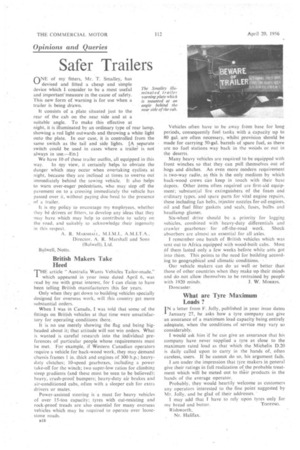Opinions and Queries
Page 52

If you've noticed an error in this article please click here to report it so we can fix it.
Safer Trailers
QNE of my fitters, Mr. T. Smalley, has
devised and fitted a cheap and simple device which I. consider to be a most useful and important measure in the cause of safety. This new form of warning is for use when a trailer is being drawn.
It consists of a plate situated just to the rear of the cab on the near side and at a suitable angle. To make this effective at night, it is illuminated by an ordinary type of rear lamp, showing a red light outwards and throwing a white light onto the plate. In our case, it is controlled from the same switch as the tail and side lights. . [A separate switch could be used in cases where a trailei is not always in use.—ED.1 We have 10 of these trailer outfits, all equipped in this way. In my view, it certainly helps 'to obviate the danger which may occur when overtaking cyclists at night, because they are inclined at times to swerve out immediately behind the towing vehicle. It also helps to warn over-eager pedestrians, who may step off the pavement on to a crossing immediately the vehicle has passed over it, without paying due heed to the presence of a trailer.
It is my policy to encour.age my employees, whether hey be drivers or fitters, to develop any ideas that they may have which may help to contribute to safety on the road, and suitably to acknowledge their ingenuity in this respect. A. R. MARSHALL, MIMI, A.M.I.T.A., Director, A. R. Marshall and Sons (Bulwell), Ltd.
Bulwell, Notts.
British Makers Take Heed. THE article "Australia Wants Vehicles Tailor-made." I which appeared in your issue dated April 6, was read by me with great interest, for I can claim to have been telling British manufacturers this for years.
Only when they get down to building vehicles specially designed for overseas work, will this country get more substantial orders. .
When 1 Was in Canada, I was told that some of the fittings on British vehicles at that time were unsatisfactory for operating conditions there.
It is no use merely showing the flag and being bigheaded about it; that attitude will not win orders. What is wanted is careful research into the individual preferences of particular people whose requirements must be met. For example, if Western Canadian operators require a vehicle for back-wood work, they may demand chassis frames 1 in. thick and engines of 300 h.p.; heavyduty clutches; 10-speed gearboxes, including a power take-off for the winch; two super-low ratios for climbing steep gradients (and these must be seen to be believed); heavy, crash-proof bumpers; heavy-duty air brakes and air-conditioned cabs, often with a sleeper cab for extra drivers or mates.
Power-assisted steering is a must for heavy vehicles of over 15-ton capacity; tyres with cut-resisting and rock-proof treads arc also essential for many overseas vehicles which may be required to operate over loose. stone roads. Vehicles often have to be away frOrn base for long periods, consequently fuel tanks with a capacity up to 80 gal. are often necessary, whilst provision should be made for carrying 50-gal. barrels of spare fuel, as there are no fuel stations way back in the woods or out in the deserts.
Many heavy vehicles are required to be equipped with front winches so that they can pull themselves out of bogs and ditches. An even more modern requirement is two-way radio, as this is the only medium by which back-wood crews can keep in touch with their base depots. Other items often required are first-aid equipment; substantial 'fire extinguishers of the foam and ordinary types, and spare parts for vital engine repairs, these including fan belts, injector nozzles for oil engines. oil and fuel filter gaskets and seals, fuses, bulbs and headlamp glasses. Six-wheel drive should be a priority for logging vehicles, combined with 'heavy-dtity differentials and crawler gearboxes' for off-the-road work. Shock absorbers are almost an essential for all axles.
remember one batch of British vehicles which was sent out to Africa equipped with wood-built cabs. Most Of them lasted only a few weeks before white ants got into them. This points to the need for building accord
ing to geographical and climatic conditions. . Our vehicle makers can do as well or better than those of other countries when they make up-their minds and do not allow themselves to be restrained by people
with 1920 minds, J. W. MORRIS. Doncaster.
What are Tyre Maximum Loads ?
IN a letter from F. Jolly, published in your issue datea
January 27, he asks how a tyre company can give an assurance of a maximum load capacity being entirely adequate, when the conditions of service may vary so considerably.
I would ask him if he can give an assurance that his company have never supplied a tyre as close to the maximum rated load as that which the Michelin D.20 is daily called upon to carry in the hands of, often careless, users. If he cannot do so, his argument fails. I am under the impression that tyre makers in general give their ratings in full realization of the probable treatment which will be meted out to their products in the hands of the average operator. Probably, they would heartily welcome as customers any operators interested to the fine point suggested by Mr. Jolly, and he glad of their addresses. I may add that I have to rely upon tyres only for
my bread and butter. TOOTING. R ishworth.
Nr. Halifax.




















































































































